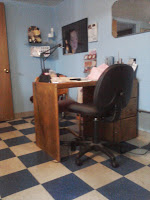Those of
you who are seriously concerned about the spread of Coronavirus and other flu viruses
should be looking into cross-contamination prevention rather than attempting to
defeat contamination with constant hand-washing- which is not a feasible option
if you plan on having normal days away from the facilities you would need in
order to ‘keep clean’.
In
truth, washing your hands constantly doesn’t sterilize them! Only hand sanitizers that have at
least a 70% (or higher) ethyl alcohol content can kill most bacteria and
similar microbes to 99%. You’re probably wondering at this point if there is
any way, then, to prevent the spread of this virus by hand contact!
I feel
that the best preventative is to follow the example of surgical physicians who
not only scrupulously wash their hands prior to surgeries (and clear up to the
elbow, by the way!) but also wear surgical
gloves- and often two layers of gloves because it’s so easy for the gloves
to be compromised by suture needles and scalpels, etc. (Even double–gloving can’t fully guard
against micro-perforations, so doctors, surgical assistants and attendants may
change gloves often during a single operation.) This process, however, is the
essence of preventing cross-contamination.
You’re probably wondering how this
practice could feasibly be used in an every day consumers day-to-day life that
is relevant and comprehensive. Since the break out of the super flu virus
COVID-19, I have personally been using disposable gloves on my hands which I
don prior to going into stores- before I ever have to manually pull a
publicly-used door open! I keep the gloves on while I shop, check out and after
I leave the store I pull them off and properly discard them in a wastebasket. You
can buy very inexpensive plastic liner gloves in a dollar store for about $1
per hundred. This process makes hand washing irrelevant and unnecessary. It protects
you, other shoppers, the checkout clerk and even the stock workers. What could
be easier than that, I ask?
May 28, 2020 update:
In case you’re unfamiliar, here’s a quick recap of how to safely remove your gloves:
May 28, 2020 update:
In case you’re unfamiliar, here’s a quick recap of how to safely remove your gloves:
- Grasp the outside of one glove at the wrist, being careful not touch your skin.
- Peel the glove away from your body, pulling it inside out.
- Hold the glove you just removed in your other gloved hand.
- Peel off the second glove by putting your fingers inside the glove at the top of your wrist.
- Turn the second glove inside out while pulling it away from your body, leaving the first glove inside the second.
- Throw the gloves into the trash immediately. (Don’t leave them in the store parking lot outside of your vehicle or try to reuse them later.)
- Wash your hands or use hand sanitizer directly after you’ve removed the gloves, if you wish.
How do I know about this, you say? Well,
as a licensed professional manicurist I was trained in sterilization and
sanitization while I attended school for my diploma. While in school I did 60
hours instruction and practice in sterilization and sanitization- 20 more hours
than is required by law- and I received high grades in every aspect of my
training. I received a 100% on sterilization.
There are some codes and regulations that
licensed beauty professionals must adhere to, concerning public safety and
health, not just for themselves but the public that they work on every day. The
two most important regulations concerning the prevention of spreading viruses
are under:
Section 7312 (e), Busi. and
Prof. Code 983 (b) Every licensee or
student performing services shall thoroughly wash his or her hands with soap
and water and/or any equally effective alcohol-based hand-cleaning product
immediately before serving each client.
Section 7312, (e) Busi. and
Prof. Code 984 (a) No establishment
or school shall knowingly permit a licensee or student afflicted with an
infection or parasitic infestation capable of being transmitted to a client, to
serve clients or train in the establishment or school.
The latter is also under the Health and Safety
Code under section 121365 for the California State Board. Colorado and most other states have
identical or similarly written and published codes with numerous others under
Article 12.
There are more numerous and extensive laws
that prevent us from doing any services on potential patrons who
have infectious diseases and illnesses, as well. This is obviously also
a cross-contamination prevention measure which should be strictly enforced but many
nail salons are being run by unlicensed techs whose salons are
often also unlicensed. I’m sure you can see the potential dangers that lurk
in ignorance of these laws.
Application of these laws for both patron
and nail techs is imperative in times when virus breakouts like COVID-19 are in
a state of epidemic for a nation the size of ours. Obviously, the uses of
gloves are not practical or feasible for the patron in these cases, so the
nail tech needs to be as vigilant and aware as the patron in discerning
problems either way. Get yourself educated. Talk about these concerns with the
potential tech before you ever walk through those doors and make certain that
you will be protected. If you are sick, quarantine yourself. Think of others.
Be responsible. The life you save may be your own.
























